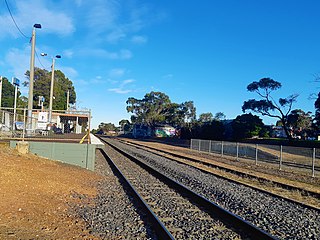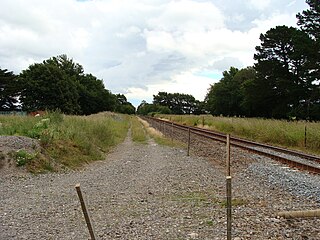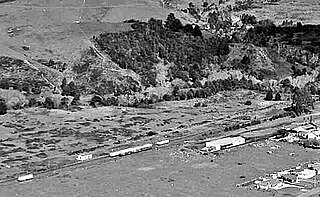
Somerville railway station is a commuter railway station on the Stony Point line, part of the Melbourne railway network. It serves the town of the same name in Victoria, Australia. Somerville is a ground level unstaffed station, featuring one side platform. It opened on 10 September 1889.

Newton Abbot railway station serves the market town of Newton Abbot in Devon, England. It is 214 miles 5 chains (345 km) from London Paddington. The station today is managed by Great Western Railway, who provide train services along with CrossCountry.
Lepperton is a small village in North Taranaki, New Zealand. It is approximately 6 km (3.7 mi) inland from Waitara township, 5 km (3.1 mi) west of the Waitara River, and 1 km (0.62 mi) east of State Highway 3A, which connects Inglewood to Waitara.

Pahiatua railway station is on the Wairarapa Line in New Zealand's North Island. It was opened in May 1897, shortly before the line was opened to Woodville in December of that year. The station is located in Mangamutu, 1.7 kilometres (1.1 mi) west of Pahiatua, in contrast to the original plans for the railway line to run through the town.
The Cambridge Branch is a rural railway line in the Waikato, New Zealand. The line stretches from Ruakura Junction for 15.08 kilometres (9.37 mi) to the settlement of Hautapu, having previously continued another 4.19 kilometres (2.60 mi) to the township of Cambridge. It had five stations along its length, at Newstead, Matangi (Tamahere), Bruntwood (Fencourt), Hautapu and the terminus at Cambridge.
The Waitara Branch is a 7.245 km long branch line railway in the Taranaki region of New Zealand's North Island. It was built as part of the region's first railway, linking New Plymouth with the closest suitable port, then the river port of Waitara. In 1884 the Breakwater port was opened in New Plymouth, but the line was saved when a (meat) freezing works was opened at Waitara in 1885.

Dalefield railway station was a station on the Wairarapa Line that served the small rural community of Dalefield, just south of Carterton in the Wairarapa region of New Zealand’s North Island. It survived for just over a century from when the line opened in 1880 until it was closed in 1981.

Clareville railway station was a flag station serving the small settlement of Clareville, north of Carterton in the Wairarapa region of New Zealand's North Island. It survived for nine decades from when it opened in 1880 until closure to all traffic in 1970.

Mauriceville railway station was a rural railway station that served the small village of Mauriceville in the Wairarapa region of New Zealand’s North Island. It was located on the Wairarapa Line between the stations of Kopuaranga and Mangamahoe with direct vehicular access from Opaki Kaiparoro Road.

The Waitara Railway Preservation Society is a society established in 1999 to operate a heritage railway over the former Waitara Industrial Line railway that operated between Lepperton and Waitara in the New Plymouth District of New Zealand's North Island. The line had been closed that year after 124 years of operation, after the closure of the local AFFCO freezing works in the town.

Moerewa railway station was a flag station at Moerewa on the Opua Branch of the North Auckland Line in New Zealand.

Longburn railway station was a station in Longburn, on the North Island Main Trunk in New Zealand. The platform, which is across from the Fonterra Factory, remains but the structure has been demolished.

Makino Road railway station was a station on the North Island Main Trunk in New Zealand. It was a request stop, 49 mi (79 km) south of Wanganui and 2 mi (3.2 km) north of Feilding.
The Kapuni Branch, formerly known as the Opunake Branch, is a branch railway in North Island, New Zealand. It opened in 1926, and ran 36.4 km across the southern slopes of Mount Taranaki to link the rural town of Ōpunake with the Marton–New Plymouth Line 2 km north of the small rural settlement of Te Roti, equidistant between Eltham and Hāwera. With the decline of rural freight, part of the line was closed in 1976, but the 10.9 km section to Kapuni was retained and upgraded to service traffic to the Kapuni natural gas field.

Brixton Road railway station served the village of Brixton, Devon, England from 1898 to 1960 on the Plymouth to Yealmpton Branch.
Inglewood railway station is a single-platform railway station on the Marton - New Plymouth Line serving the town of Inglewood in New Zealand's Taranaki district. Located on Moa Street, the station is the oldest remaining railway station in New Zealand still on its original site.

Waiongona railway station was a rural railway station on the Marton - New Plymouth Line serving the small locality of Waiongona in New Zealand's Taranaki district. Located on Mountain Road, the station was relocated from its original site in 1893. The station closed to all traffic in 1958, though freight trains continue to pass through the station site.

Lepperton railway station is a rural railway station on the Marton–New Plymouth line serving the village of Lepperton in New Zealand's Taranaki district. It is also the junction with the 7.25-kilometre (4.50 mi) Waitara Branch railway line.

Sentry Hill railway station was a rural railway station on the modern day Waitara Branch railway. It also served as the junction between the New Plymouth - Waitara railway and the main line south until the junction was relocated to Lepperton in 1908.

Waitara railway station is an urban railway station on the Waitara Branch railway serving the regional town of Waitara in New Zealand's Taranaki district. It previously served the local freezing works and local port.
















